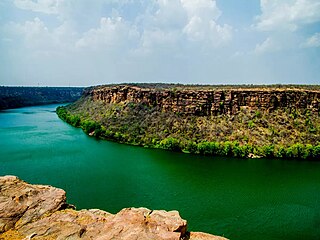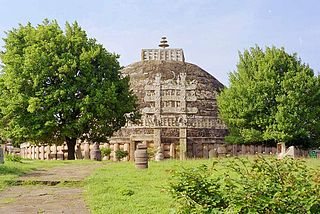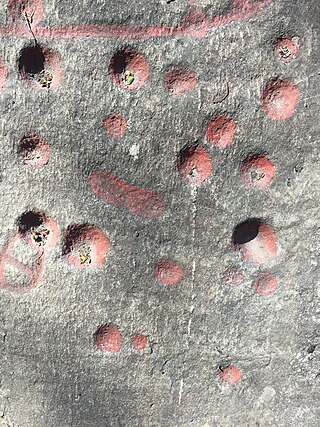
The Bhimbetka rock shelters are an archaeological site in central India that spans the Paleolithic and Mesolithic periods, as well as the historic period. It exhibits the earliest traces of human life in India and evidence of the Stone Age starting at the site in Acheulian times. It is located in the Raisen District in the Indian state of Madhya Pradesh, about 45 kilometres (28 mi) south-east of Bhopal. It is a UNESCO World Heritage Site that consists of seven hills and over 750 rock shelters distributed over 10 km (6.2 mi). At least some of the shelters were inhabited more than 100,000 years ago.

Mandsaur is a city and a municipality in Mandsaur district located on the border of Mewar and Malwa regions of Madhya Pradesh, a state in Central India. It is the administrative headquarters of Mandsaur District. The ancient Pashupatinath Temple is located in Mandsaur.

The Chambal River is a tributary of the Yamuna River in Central and Northern India, and thus forms part of the drainage system of the Ganges. The river flows north-northeast through Madhya Pradesh, running for a time through Rajasthan, then forming the boundary between Rajasthan and Madhya Pradesh before turning southeast to join the Yamuna in Uttar Pradesh state.

Mewar or Mewad is a region in the south-central part of Rajasthan state of India. It includes the present-day districts of Bhilwara, Chittorgarh, Pratapgarh, Rajsamand, Udaipur, Pirawa Tehsil of Jhalawar District of Rajasthan, Neemuch and Mandsaur of Madhya Pradesh and some parts of Gujarat.

Bhind district is a district in the Chambal division of the Indian state of Madhya Pradesh. The town of Bhind is the district headquarters.Bhind District is situated in Chambal region in the northwest of the state.

GandhisagarDam is situated at a distance of 168 km from the District headquarter. The Dam is constructed on the Chambal River.

Mandsaur district is a District of Madhya Pradesh state in central India. The town of Mandsaur is the administrative headquarters of the district.The ancient Pashupatinath temple is situated in Mandsaur. Large quantities of opium are produced in Mandsaur district.

Pashupatinath Temple at Mandsaur, also referred to as the Mandsaur Shiva temple, is a Hindu temple dedicated to Lord Shiva in Mandsaur, Madhya Pradesh, India. It belongs to Pashupatinath tradition which is one of 6 major tradition within Shaivism. It is located on Shivna River, and is known for its eight-faced Shiva Linga. The temple sculpture is dated to the 5th or 6th century based on inscriptions, with some referring to the site as Dashapura. It is near the Rajasthan border in the historic region of Malwa, about 200 kilometres (120 mi) from Indore, about 340 kilometres (210 mi) west of Udaigiri Caves and about 220 kilometres (140 mi) east of Shamalaji ancient sites, both a significant source of Gupta Empire era archaeological discoveries. The site has been important to dating and the architectural studies of some distant sites such as the Elephanta Caves.

Vishnu Shridhar Wakankar was an Indian archeologist. Wakankar is credited with the discovery of the Bhimbetka rock caves in 1957 and the Kayatha culture in 1964, among others. In 2003, UNESCO inscribed the Bhimbetka rock caves as a World Heritage Site. The Bhimbetka rock caves exhibit one of the earliest traces of human life in India.
Sabalgarh is a municipality in Morena district in the Indian state of Madhya Pradesh.
The Jawahar Sagar Dam is the third dam in the series of Chambal Valley Projects on the Chambal River, located 29 km upstream of Kota city and 26 km downstream of Rana Pratap Sagar dam. It is a concrete gravity dam, 45 meters high and 393 meters long, generating 60 MW of power with an installed capacity of 3 units of 33 MW. Its construction was completed in 1972. The dam's gross storage capacity is 67.07 million cubic meters. The total catchment area of the dam is 27,195 km2, of which only 1,496 km2 are in Rajasthan. The free catchment area below Rana Pratap Sagar dam is 2,331 km2. The dam is located after the Gandhi Sagar Dam and Rana Pratap Sagar Dam, but before the Kota Barrage.

Tourism in Madhya Pradesh has been an attraction of India because of its location in the centre of the country. Madhya Pradesh has won Best Tourism State National award for 3 consecutive years i.e. 2017, 2016 and 2015.

Madhya Pradesh, often called the Heart of India, is a state in central India. Its capital is Bhopal. Madhya Pradesh was originally the largest state in India until November 1, 2000 when the state of Chhattisgarh was carved out. It borders the states Uttar Pradesh, Chhattisgarh, Maharashtra, Gujarat and Rajasthan.

Mandsaur Fort, is situated in Mandsaur city in Mandsaur district in Indian state of Madhya Pradesh.

Gandhi Sagar Sanctuary is a wildlife sanctuary situated on the northern boundary of Mandsaur and Nimach districts in Madhya Pradesh, India. It is spread over an area of 368.62 km2 (142.32 sq mi) adjoining Rajasthan state in India. It was notified in 1974 and more area was added in 1983. The Chambal River passes through the sanctuary dividing it into two parts. The western part is in Nimach district and eastern part is in Mandsaur district. It is in the Khathiar-Gir dry deciduous forests ecoregion.

Malwa Ki Sanskritik Virasat Evam Paryatan is a book written by Subhash Kumar Sojatia. It was released by Sonia Gandhi.

Rock cupules are artificially made depressions on rock surfaces that resemble the shape of an inverse spherical cap or dome. They were made by direct percussion with hand-held hammer-stones, on vertical, sloping or horizontal rock surfaces. Cupules are widely believed to be the world's most common rock art motifs, found in huge numbers in every continent except Antarctica. They were produced in many cultures, from the Lower Paleolithic to the 20th century, and they can be found on most lithologies. Similar artifacts from lithic Native American cultures are also known as cupstones.

Subhash Kumar Sojatia is an Indian politician and former Minister of Home, Health, Industry, Commerce, Medical Education and Public Relations in the Government of Madhya Pradesh. He was born on 30 March 1952 in the small town of Bhanpura, located in the Mandsaur District in the Malwa region of Madhya Pradesh. Sojatia received his education at Holkar Science College.

Hinglajgarh is an ancient fortress in Navali, Mandsaur District, Madhya Pradesh, India. The fortress has been controlled by multiple rulers, and has been rebuilt and revamped throughout the ages. The name Hinglajgarh comes from the Goddess Hinglaj Devi, of which a temple dedicated to her is located on the southern portion of the fortress. The fortress has also been described as a city or fortress city.























